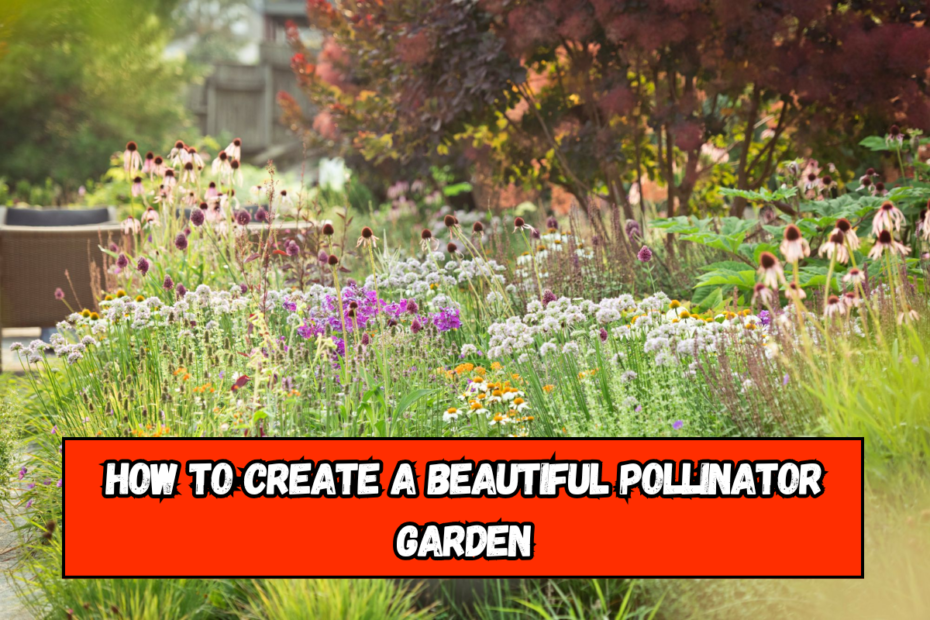How to Create a Beautiful Pollinator Garden: A beautiful pollinator garden attracts butterflies, bees, hummingbirds, and other pollinators while adding color and energy to your outdoor space.
How to Create a Beautiful Pollinator Garden
These gardens beautify your landscape and support pollinators while improving the environment. This comprehensive book shows how to design a beautiful and effective pollinator garden.
Choose the Right Location
The first step to a good pollinator garden is location. Choose an area with at least 6-8 hours of direct sunlight everyday for pollinator-friendly plants. Your blooms will produce plenty of nectar and attract many pollinators in the sun.
Wind protection is another factor. A protected area helps pollinators visit flowers and prevents wind from blowing pollen away. Consider installing a tiny birdbath or shallow dish of water with stones to your garden near a water source. Bees and butterflies can relax here while drinking.
Select Native Plants
Choose native plants to attract local pollinators. Pollinators need nectar and pollen from native plants, which are tailored to your environment. A variety of native plants that bloom at different times will feed bees, butterflies, and other visitors year-round.
Design your garden with a range of flower forms and hues. Bees adore purple, blue, and yellow flowers, whereas hummingbirds like red and orange. Native plants like coneflower, milkweed, bee balm, lavender, sunflowers, and goldenrod are great. Find local variety for optimal outcomes.
Plan for Blooming Seasons
Pollinator gardens with seasonal flowers are well-planned. This provides pollinators with food in spring, summer, and fall. Grouping similar flowers helps pollinators identify their favored nectar sources, providing more efficient feeding zones.
Plant early bloomers like columbine and lupine in spring. Bee balm, black-eyed Susans, and purple coneflowers supply nectar in June. Autumn asters and goldenrod are ideal for feeding pollinators before winter. This year-round strategy will support pollinators and beautify your landscape.
Provide Habitat and Shelter
In addition to flowers, pollinators need nesting and shelter. Native bees can nest in bee hotels or dead logs and plant stems. Certain butterflies, like the monarch, require milkweed for their larvae. Your garden can support these insects’ full life cycle by growing host plants.
Leaving some of your garden wild might also be advantageous. Butterflies, beetles, and other insects shelter in leaf litter and rotting wood. In areas of your garden where pollinators can avoid predators and bad weather, go natural.
Also See: Banana Oatmeal Cookies Recipe
Avoid Pesticides and Chemicals
Avoiding pesticides and artificial fertilizers is crucial to pollinator gardens. Bees and butterflies can be harmed by pesticides. Focus on organic gardening instead. Pests can be controlled by ladybugs, companion planting, and DIY cures like garlic or soap sprays.
Healthy soil is essential for chemical-free gardening. Compost and organic matter boost soil nutrients, making plants more resilient and pest-resistant. Well-maintained plants attract pollinators and sustain ecosystems.
Create a Water Source
A simple water source can help garden pollinators. Bees and butterflies can drink safely from a shallow dish with water and stones or marbles. Add a small birdbath or fountain to attract hummingbirds and other pollinators. Change the water often to avoid stagnation and insects.
Puddling stations are good for butterflies. A modest area of wet sand or mud in a corner of your garden might attract butterflies and offer minerals.
Design for Beauty and Function
Beautiful pollinator gardens can be utilitarian and aesthetically pleasing. Layer taller plants in the back and shorter ones in the front for visual appeal. The method looks wonderful and makes flowers easier for pollinators to access.
Installing stone, wood, or gravel pathways or borders can make it easier to navigate your garden and enjoy nature. These walkways allow you to see bees, butterflies, and birds in your yard, creating a serene and pleasant atmosphere.
Incorporate Fragrant Plants
Fragrant plants make your garden more immersed. Lavender, thyme, and mint attract bees and scent your yard. Planting scented flowers and herbs can make your garden as delightful as the pollinators’.
Moths are drawn to night-blooming flowers like evening primrose. These blooms may make your landscape magical at night.
Maintain and Monitor Your Garden
Your pollinator garden needs frequent care to thrive. Deadhead wasted blooms to promote new growth and clip plants to keep them tidy. Check for aphids and remove them by hand or with a mild spray.
Check plant performance and make modifications. Consider replacing struggling flowers with better ones. A little maintenance will keep your garden a pollinator refuge year after year.
Conclusion
Create a gorgeous pollinator garden in your backyard to support biodiversity and enjoy nature. Choose native plants, plan for multiple flowering seasons, provide cover, and avoid pesticides to create a beautiful, pollinator-friendly landscape. Be patient and your pollinator garden will become a colorful, buzzing paradise that attracts a variety of insects and birds, bringing life and color to your outdoor environment.
